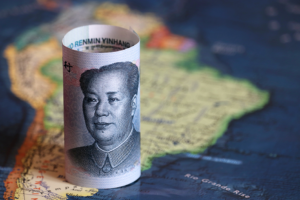The Use Of Chinese Currency Yuan In International Trade
China’s increasing weight in global trade in the recent period has led to an increase in the weight of the yuan in the international financial system
In global international trade, 75-90 per cent of the payments made in international trade in the last 20 years have been in euro and US dollars. Euro has been used in the European continent, while the US dollar has been used more frequently in the Americas, Asia, and Africa in comparison. Besides, even though different currencies such as sterling, yen, and yuan are also used in foreign trade payments, their share is very low. On top of the above-mentioned dominance of the US dollar and euro in payment systems, they also have
a significant weight in terms of the share in the reserves of central banks. By the third quarter of 2022, the share of the US dollar in central banks’ reserves is 60 per cent and the share of the euro is around 20 per cent. The share of yuan is only 2.8 per cent.
Despite the dominance of the US dollar and the euro in both foreign trade payments and the reserves of central banks, there have been significant attempts to establish methods to make payments in other currencies recently. Especially following the Russia-Ukraine war, the sanctions and restrictions imposed on the international financial system caused this issue to gain even more importance.

Is it possible for the Chinese yuan to become popular as a means of payment in global trade?
China’s increasing weight n global trade in the recent perios and as a result being a production and export hub has led to an increase in the weight of the Chinese currency Yuan in the international financial system. The most concrete example of this was the inclusion of the yuan in the IMF’s Special Drawing Rights (SDR) in 2016. In order for a currency to be included in the SDR calculation, 2 basic criteria are taken into account by the IMF. First, the country’s currency must belong to one of the top exporting countries. China is the world’s largest exporter with an export of USD 3.6 trillion in 2022, meeting this criterion very easily. Another criterion taken into account by the IMF is that money can be freely used as a means of payment in global trade and can be traded on stock exchanges. In terms of this criterion, there is no problem with the SDR calculation of the yuan.
Therefore, being included in the SDR calculation since 2016, the yuan became the third largest currency with a share of 12.28 per cent, after 43.38 per cent of the US dollar and 29.31 per cent of the euro. Besides the SWIFT system, which is a global payment system used by the Western Bloc (US and EU countries), the CIPS system, which was brought to the agenda by China, has been another significant step. All these developments pave the way for the yuan to be used as a means of payment in foreign trade in the future. It would be appropriate to take certain additional steps to use the yuan as a means of payment in global foreign trade. First of all, instead of becoming a global currency, it should be prioritized that payment is made in the yuan in certain areas. One of these areas is global energy trade. Energy trade is around 11 per cent of global trade, and energy-exporting countries generally accept payments in US dollars for these exports. However, especially after the Russia-Ukraine war, Russia’s started to export energy in exchange for rubles weakened this hegemony.

On top of the above-mentioned dominance of the US dollar and euro in payment systems, they also have a significant weight in terms of the share in the reserves of central banks
In addition, the issue of oil exports in the yuan currency, which came to the agenda during the visit of Chinese leader Xi to Saudi Arabia in the last month of 2022, may be considered a significant step in terms of the yuan becoming a means of payment in international trade. Secondly, in order for a currency to be used as a means of payment in foreign trade, the financial system of that country is expected to be integrated into the international financial system. The USA, the owner of the US dollar, is the best example of this. Many financial institutions are located in international financial centres and as such, the USA is very closely integrated into the international financial system. Likewise, in European countries that use the euro, the financial system is integrated with the international financial system. From this point of view, we can say that China lags behind a bit. Even though it has huge banks, the integration of these banks into the international financial system is not at the desired level. Finally, the use of the yuan as a regional payment instrument before becoming a global payment instrument may be considered. What is meant by regional may refer to the energy trade mentioned above, as well as
China’s geographically close neighbours in far east Asia.

From this point of view, the use of the yuan in trade with RCEP (Regional Comprehensive Economic Partnership) countries may be considered in the first stage. RCEP countries are a group of 15 countries formed by the addition of Australia, China, Japan, and New Zealand to 10 ASEAN countries and have become a significant partnership in foreign trade. China has a significant weight in this group and 46 per cent of the foreign trade in the region is made with China. China is believed to have the necessary infrastructure for the yuan to
be used in the foreign trade of these countries in the future. As a result, both the recent developments in global trade and the steps taken by China to integrate into the international economic system have provided significant advantages for the yuan to be used as a payment instrument in global trade. However, further integration of Chinese banks into the global financial system should also be added to these steps.



